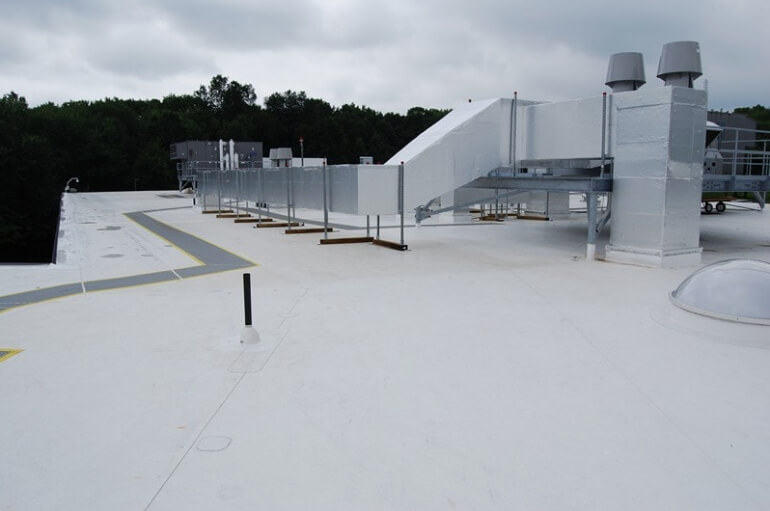
What is TPO Roofing: What is Its Purpose
Introduction
TPO (Thermoplastic Polyolefin) roofing has emerged as a leading choice for commercial and residential roofing projects due to its versatility, durability, and energy efficiency. With its numerous benefits, Thermoplastic Polyolefin roofing has revolutionized the roofing industry, providing property owners with a cost-effective and sustainable roofing solution.
Understanding TPO Roofing
Thermoplastic Polyolefin roofing is a single-ply roofing membrane composed of a blend of polypropylene and ethylene-propylene rubber. This combination results in a flexible yet sturdy roofing material that offers excellent resistance to UV radiation, heat, chemicals, and punctures. Thermoplastic Polyolefin roofing comes in different colors and sizes to meet the needs of different buildings.
Benefits of TPO Roofing
Cost-Effectiveness
One of the primary advantages of thermoplastic polyolefin roofing is its cost-effectiveness. Compared to traditional roofing materials like asphalt and metal, Thermoplastic Polyolefin roofing offers a lower upfront cost while still providing long-term durability and performance.
Durability and Longevity
TPO roofing is renowned for its durability and longevity. With proper installation and maintenance, TPO roofs can last up to 30 years or more, making them a reliable investment for property owners.
Energy Efficiency
Thermoplastic Polyolefin roofing is highly reflective, which helps to reduce heat absorption and energy consumption in buildings. By reflecting sunlight away from the roof surface, Thermoplastic Polyolefin roofing helps to keep interior spaces cooler, leading to lower cooling costs and increased energy efficiency.
Installation Process
The installation process of Thermoplastic Polyolefin roofing typically involves cleaning and preparing the roof surface, applying adhesive or heat-welding the membrane seams, and ensuring proper flashing and edge detailing for waterproofing. Thermoplastic Polyolefin roofing can be installed quickly and efficiently by trained roofing professionals.
Maintenance and Repairs
Maintaining TPO roofing is relatively simple and requires regular inspections, cleaning, and minor repairs as needed. By addressing any issues promptly, property owners can prolong the lifespan of their TPO roof and prevent costly damage or leaks.
Comparison with Other Roofing Materials
Compared to alternatives like PVC (Polyvinyl Chloride) and EPDM (Ethylene Propylene Diene Monomer), Thermoplastic Polyolefin roofing offers several advantages, including superior weather resistance, energy efficiency, and ease of installation. Additionally, Thermoplastic Polyolefin roofing is recyclable and contributes to a more sustainable building environment.
Applications of TPO Roofing
Thermoplastic Polyolefin roofing is suitable for a wide range of applications, including flat roofs, low-slope roofs, and green roofs. It has uses in commercial buildings, industrial facilities, and residential homes due to its versatility and compatibility with different building types.
Environmental Impact
Thermoplastic Polyolefin roofing is environmentally friendly because it is recyclable and contributes to energy efficiency. Its reflective properties help to reduce the urban heat island effect and minimize the carbon footprint of buildings, making it a sustainable choice for environmentally conscious property owners.
Future Trends
The future of Thermoplastic Polyolefin roofing looks promising, with ongoing research and development focused on improving its performance, sustainability, and cost-effectiveness. Emerging trends include advancements in material technology, increased focus on recyclability, and enhanced energy efficiency features.
Conclusion
In conclusion, Thermoplastic Polyolefin roofing offers a range of benefits that make it an attractive choice for modern building projects. From its cost-effectiveness and durability to its energy efficiency and environmental friendliness, Thermoplastic Polyolefin roofing provides property owners with a reliable and sustainable roofing solution.
FAQs
- Is Thermoplastic Polyolefin roofing suitable for residential buildings?
- Yes, TPO roofing is commonly useful in residential applications due to its durability and energy efficiency.
- How long does Thermoplastic Polyolefin roofing last?
- With proper maintenance, TPO roofing can last up to 30 years or more.
- Can Thermoplastic Polyolefin roofing be installed on sloped roofs?
- While TPO roofing is typically used on flat or low-slope roofs, it can be installed on sloped roofs with proper design and installation techniques.
- Does thermoplastic polyolefin roofing require special maintenance?
- TPO roofing requires regular inspections and cleaning to ensure optimal performance and longevity.
- Is thermoplastic polyolefin roofing environmentally friendly?
- Yes, TPO roofing is environmentally friendly because it is recyclable and contributes to energy efficiency.
Visit our website for more. Click here: “Quick Trend Insights“.





